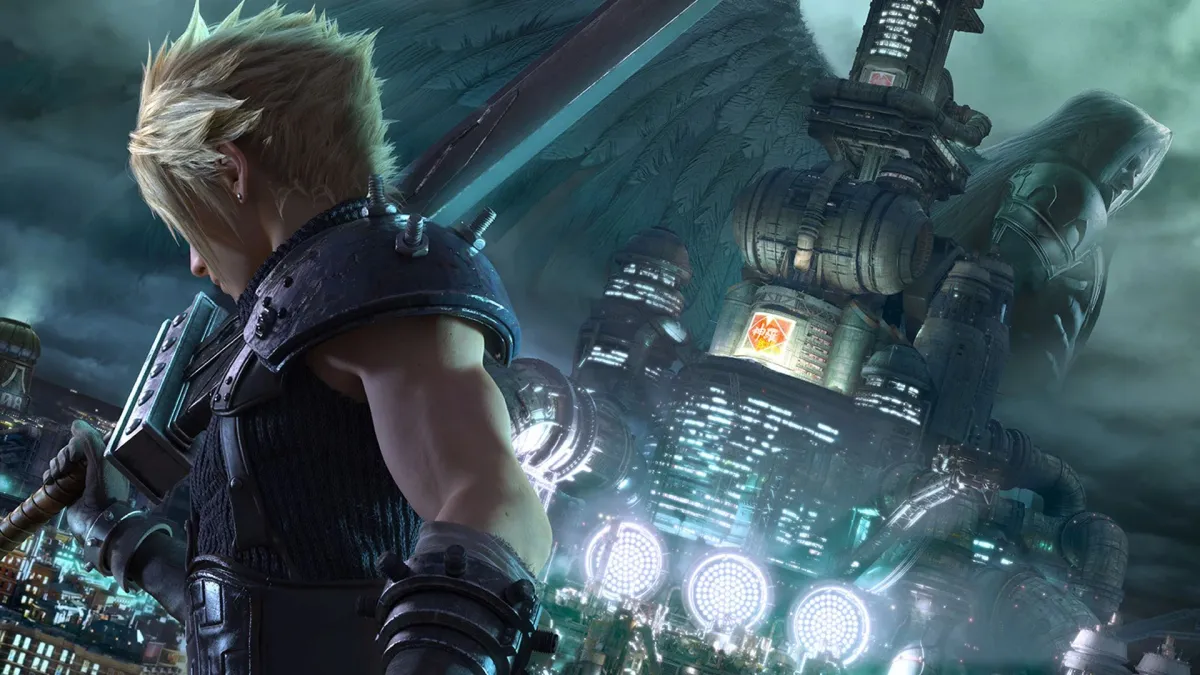There are few games out there that can garner the same level of jubilation that Final Fantasy VII received back in 2015 when it was announced that that it was being remade for the PS4 during Sony’s E3 conference. For awhile, Square Enix was pretty reserved on releasing any new information or footage for the game, though that has certainly changed over the last year or so. Now nearly five years have passed since the initial reveal and the first part of the story has finally arrived with Final Fantasy VII Remake.
The original Final Fantasy VII changed the landscape of gaming when it released back in 1997 for the PlayStation. Just like Metal Gear Solid did a year later, the story telling and cutscenes were a major game changer, along with the gameplay and how expansive of a game it really was. Even if the visuals have not held up over the years, this shaped not only the future of the Final Fantasy series, but RPGs and even gaming as a whole. This means that Final Fantasy VII Remake certainly had a lot to live up to in its remake form, which has taken a unique approach by expanding upon the story by splitting the game into multiple parts.

Just like the classic, Final Fantasy VII Remake features lead protagonist and ex-SOLDIER Cloud Strife, who has now begun to do merc work for money. This leads him to the eco-terrorist group Avalanche, who are trying to blow up the Mako Reactors found around the city of Midgar before they drain the planet of its life essence. Cloud is quickly introduced to Barret, along with characters who had fairly minute roles in the original like Jessie, Biggs, and Wedge, as they participate in the first bombing run. This is really the first sign of how much larger in scale this game is in comparison, as these previously side characters have more personality than they ever did in the original in only the opening sections.
It’s not just the side characters that get more fleshed out in this version either, as the main characters feel more full of life than ever before. Everyone knows about the infamous Aerith moment in the original, but now you get to see that relationship between her and Cloud grow even more. That also goes for the relationship between Tifa and Cloud, where you can really feel the bond they have from the past that has been rekindled. The teases of Cloud’s past also get to be more front and center, including his hallucinations of Sephiroth that happen early on in the game. This really adds even more to the mystique of their relationship, both for those that played the original and those who did not.
Square Enix also made the choice to replace all of the existing cast from any past media such as Advent Children in lieu of a brand new voice cast. This may have been controversial for some, but the cast they brought in for this game does a superb job at capturing each of the characters. From Cloud’s stoic demeanor to Aerith’s hopeful nature, the voice cast really nails what makes each of the characters so special and really bounce off of one another very well.
Not long after the bombing run, you finally get to explore Midgar a little bit starting with the Sector 7 Slums. Those expecting the game to have a completely open world structure like Final Fantasy XV may feel a little letdown at first, with the game having a more limited number of areas to explore across Midgar that you can only go back and forth between at certain times. At the same time, the game does not feel anywhere near as linear as the majority of Final Fantasy XIII, which was one of the biggest complaints that people had about the game when it released. There are some people who may still find this game a little too linear at times, but it really does work well here.

With Final Fantasy VII Remake expanding much more so upon Midgar, this makes the world itself feel a lot more alive and ripe for checking out. When you make it to towns like the Sector 7 Slums or especially Wall Market, there are lots of different areas to check out around the town, whether it leads to a side quest or just to find some sort of hidden item. While you won’t come across the type of exploration found in games like Uncharted and the like, there are plenty of moments where you have to go under rubble, climb ladders, or solve a puzzle to continue forward in your path. This especially is where it could have been nice to have the ability to jump, such as in Kingdom Hearts, but instead you are mostly relegated to the ground outside of combat.
For those that never played the original, Midgar was only a small portion of the large game that was Final Fantasy VII. In fact, you left Midgar while still on disc one in less than probably 10 hours. This meant that a lot had to be added into the remake, both with the story and the characters themselves. As aforementioned, characters like Jessie, Biggs, and Wedge were just a means to push the plot forward in the original before disappearing entirely, but now they have a major impact throughout the entire first remake entry. These aren’t simply just extra sidequests or anything either, as there is an entire chapter of the game dedicated to these characters where Cloud goes off alone with them. Jessie in particular gets an emotional story this time around that helps to make the overall story even more impactful than in the past.
This is also the chapter in which the game introduces you to a brand new character entirely in the remake known as Roche. Along with Roche, the game introduces motorcycle gameplay that includes a boss battle against him that comes in handy later in the game as well. It is a bit surprising how little we actually see of him in this game though, but hopefully that means he has a bigger role to play in the future. There are also other new characters brought into the mix as well, namely in Wall Market, who each play interesting roles in the plot. None of them are as big as the Avalanche members, but still are great additions to the mythos.
With new characters being introduced like Loche that seem to have a bigger role to play later, it almost seems like Square Enix is almost going with a Rebuild of Evangelion strategy in that some things are definitely changing in the story. This is largely seen with the new Dementor looking entities known as Whispers that play a major role in the story from very early on when Cloud and Aerith first meet. The question moving forward will be how the future entries handle this, whether they follow the remainder of the lengthy story more closely, as there is more to use, or if they will make many more changes along the way.

Final Fantasy VII Remake has looked stellar since its initial reveal and the game certainly does not disappoint visually. This includes not just the stunning cutscenes, but also the actual environments as you’re exploring Midgar. The game does a fantastic job of transitioning from the cutscenes into gameplay almost seamlessly as well, with little in the way of loading times found in the game at all outside of chapter transitions and when fast traveling. While almost everything looks great, there are some odd looking NPC character models that almost look unfinished with a lack of detail. This isn’t a major problem since the majority of the character models and facial animations look fantastic, but it can be a little distracting when it does happen.
You cannot talk about a Final Fantasy game and not also bring up the soundtrack as well, with original composer Nobuo Uematsu returning to score the game. Music always plays a major part in helping to create an atmosphere for each area and Final Fantasy VII Remake’s soundtrack does a remarkable job of doing this. The background music for each area sets itself apart from the other, such as the drastic difference between Wall Market and the Sector 5 Slums. The iconic character themes also get a reimagining this time around and are as perfect as they were before. In fact, the first notes of “One Winged Angel” alongside the arrival of Sephiroth gave me chills as soon as they started up in the game.
Does a fantastic job of transitioning from the cutscenes into gameplay almost seamlessly
There was absolutely no way that Square Enix could just carry over the same gameplay style as the original and make the majority of gamers happy. While the gameplay in Final Fantasy VII was fantastic at the time, it definitely feels very dated in the grand scheme of things today. Instead, Square Enix managed to take what made the gameplay great back in the day and infused it with a modern day flair to create an action oriented battle system that is incredibly satisfying to use.
Rather than go with a battle system similar to Final Fantasy XV where you would only control Cloud in battle, Final Fantasy VII Remake takes some of the ideas of that combat and lets you actually play as each of your party members whenever you would like. Between the group of Cloud, Tifa, Barret, and Aerith, you will have up to three in your party at any given time and can switch in battle with ease. It did feel a bit weird to not be able to actually choose your party in certain sections of the game that had all four, with the game choosing to exclude a party member automatically.

Final Fantasy VII Remake introduces a fast paced real time battle system that lets you take control of any of your party members. While in battle, you are still able to move around the battlefield with the left analog stick and then attack the enemies directly with the respective character’s weapon by pressing Square repeatedly. Depending on the character you are using, pressing Triangle has a different special move, such as Cloud’s transition to the more powerful Punisher Mode or Aerith’s Tempest charge up attack. Having the action oriented gameplay may make you worry about the performance of the game when many enemies are on screen, but the game runs very smoothly in combat. If you end up dying in battle, you will never feel like it was the game’s fault as a result of slowdown or frame rate drops at all.
On top of that, you also have the Commands Menu at your disposal that utilizes the returning ATB gauge. When in battle, you will notice an additional gauge located under your health bar that is split into two halves, which you will need to use Abilities, Spells, and Items. Once you have filled the meter halfway, you gain the ability to cast Spells or use Items, as well as use most of your Abilities. There are also some Abilities that require the bar to be fully filled, as well as some that are stronger if you use the full bar instead of activating it with only half. Mixing in the ATB gauge in this fashion was a genius way to modernize the original ATB gauge, this time without the turn-based style gameplay.
For those that simply want a return to that more turn-based approach of the past though, the game also has what is known as Classic mode available. Classic is an actual difficulty level to choose from at the start, which you can change to in-game as well, that takes the action part out of the experience. The regular attacks and everything will be done automatically, while your only task is to use the Commands Menu. Like in the original, you will be waiting for your ATB gauge to fill up enough to where you can use your Abilities, Spells, or Items. After trying out this mode for a bit, it definitely was not the best way to experience this game, but it’s still neat to have as an option for those looking for a more traditional approach.
As a result of the structure of the game, Final Fantasy VII Remake has a smaller number of weapons available per character than you might think. Swords like Ultima Weapon and Ragnarok for Cloud are just going to have to wait, but instead the game has bolstered the weapons themselves with a robust upgrade system. Each weapon that you have in your possession will earn SP from leveling up and then allow you go to in and upgrade the weapon in many different areas, such as increased attack or magic attack power, better defense, more Materia slots or connected Materia slots, and much more. At the start, you have just one core of the weapon with around four upgrades to choose from, but there are also sub-cores that are unlocked by leveling up each character’s Weapon Level.

Besides the upgrades, each weapon also have a special ability that comes with it when equipped. These abilities are exclusive to these weapons at first, but you are able to increase proficiency for that weapon ability by using it in battle. Once you use it enough, you will unlock the ability to use this ability even when another weapon is equipped. This comes in incredibly handy, as Tifa’s Metal Knuckles are the best physical attack weapon she has throughout, but her Feathering Gloves hold the overpowering Starshower ability that can be a major help in battle.
Final Fantasy VII was very innovative in many ways, with the Materia system definitely being one of them. Materia are orbs of magic that can be equipped on your weapon and armor, thus giving you access to this Spell, Ability, or perk in battle. When you first obtain an orb of materia, it is typically at its most basic level and can then be upgraded by earning AP in battle by defeating enemies. The Materia has to be equipped to one of your active characters’ weapon or armor at the time to level up, with you gaining additional Spells and such for each subsequent level it obtains.
The game has bolstered the weapons themselves with a robust upgrade system
You can’t have a Final Fantasy game without summons either, so they are present once again as a form of Materia. The number of summons here is very limited though, since this entire game is very early in the overall Final Fantasy VII story compared to the original, so those expecting to see some of the later summons will have to wait. The summons themselves are a little random, as they will only show up as being able to be summoned during tougher battles that tend to go on for awhile. You have to watch for the Summon gauge to appear on the screen and then you will be able to finally bring forth one of them when the meter is full depending on which Materia you have equipped.
Beyond your initial summon Ifrit, a few additional summons become available during the game through a new character named Chadley. Chadley is trying to gain intel on different creatures and asks Cloud for help during an early sidequest by handing over the Assess Materia for Enemy Intel. Scanning enemies is only one part, as Chadley also asks you to gather other Battle Intel as well. This will lead you to be able to buy additional exclusive Materia, as well as gain access to VR battles against summons that you will then gain access to after defeating them. The search for more Battle and Enemy Intel adds some longevity to the game, but that is not all.

After completing the game, Final Fantasy VII Remake is far from over for the completionist types out there. Not only do you obtain additional Colosseum and Battle Simulator battles, which felt very much like a scaled down version of Kingdom Hearts’ Coliseum Cups, but you also unlock Hard Mode and a Chapter Selection. This allows you to go back and replay each chapter in whichever mode you choose with your end of game stats and equipment. It is a bit frustrating how you have to replay through story beats just to gain access to the Battle Simulator again though. Chapter Selection is also a great way to finish up sidequests and pick up some of the missed collectibles like music tracks and manuscripts, with the latter even having exclusive ones available only in Hard Mode.
Final Fantasy VII Remake has been a long time coming for fans, with rumors of it happening dating back for more than a decade prior to even its eventual reveal in 2015. Square Enix took what people loved about the original and essentially carried it into the future with upgraded gameplay and visuals that are mixed around a more expansive world than before. There is no doubt that some people will be upset with the way the game is split into multiple parts, but if Final Fantasy VII Remake’s first part is any indication, fans will be in for a fantastic ride in the coming years as the story of Cloud and company continues to unfold.
The Verdict
Taking one of the most genre defining and well loved games of all time and rebuilding it from the ground up was a tall order, but Square Enix pulled it off with modernized gameplay and a fleshing out of the world and many characters compared to the original. While only featuring a portion of the story fans know and love, Final Fantasy VII Remake still manages to feels like a complete game, yet still part of a larger narrative to come, and will have fans waiting anxiously for the next entry as soon as they finish.











Published: Apr 6, 2020 04:59 am